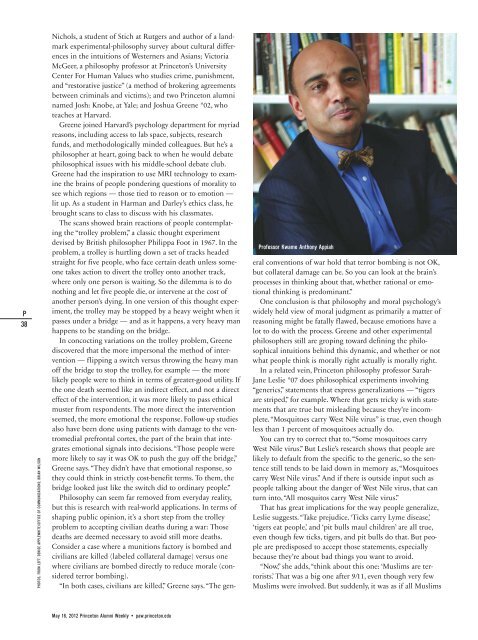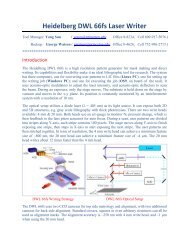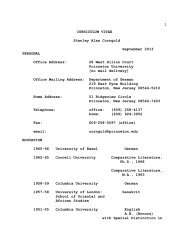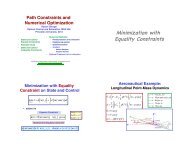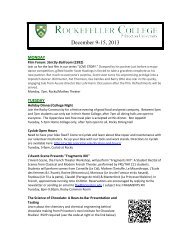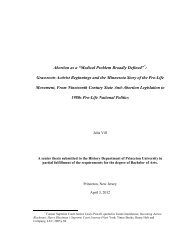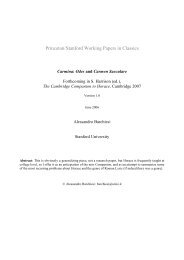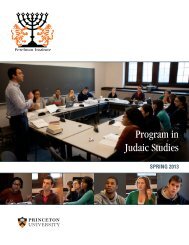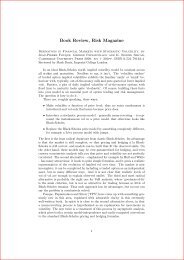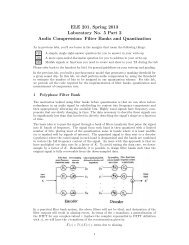Campaign residen the P -litics - Princeton University
Campaign residen the P -litics - Princeton University
Campaign residen the P -litics - Princeton University
Create successful ePaper yourself
Turn your PDF publications into a flip-book with our unique Google optimized e-Paper software.
P<br />
38<br />
PHOTOS, FROM LEFT: DENISE APPLEWHITE/OFFICE OF COMMUNICATIONS; BRIAN WILSON<br />
Nichols, a student of Stich at Rutgers and author of a landmark<br />
experimental-philosophy survey about cultural differences<br />
in <strong>the</strong> intuitions of Westerners and Asians; Victoria<br />
McGeer, a philosophy professor at <strong>Princeton</strong>’s <strong>University</strong><br />
Center For Human Values who studies crime, punishment,<br />
and “restorative justice” (a method of brokering agreements<br />
between criminals and victims); and two <strong>Princeton</strong> alumni<br />
named Josh: Knobe, at Yale; and Joshua Greene *02, who<br />
teaches at Harvard.<br />
Greene joined Harvard’s psychology department for myriad<br />
reasons, including access to lab space, subjects, research<br />
funds, and methodologically minded colleagues. But he’s a<br />
philosopher at heart, going back to when he would debate<br />
philosophical issues with his middle-school debate club.<br />
Greene had <strong>the</strong> inspiration to use MRI technology to examine<br />
<strong>the</strong> brains of people pondering questions of morality to<br />
see which regions — those tied to reason or to emotion —<br />
lit up. As a student in Harman and Darley’s ethics class, he<br />
brought scans to class to discuss with his classmates.<br />
The scans showed brain reactions of people contemplating<br />
<strong>the</strong> “trolley problem,” a classic thought experiment<br />
devised by British philosopher Philippa Foot in 1967. In <strong>the</strong><br />
problem, a trolley is hurtling down a set of tracks headed<br />
straight for five people, who face certain death unless someone<br />
takes action to divert <strong>the</strong> trolley onto ano<strong>the</strong>r track,<br />
where only one person is waiting. So <strong>the</strong> dilemma is to do<br />
nothing and let five people die, or intervene at <strong>the</strong> cost of<br />
ano<strong>the</strong>r person’s dying. In one version of this thought experiment,<br />
<strong>the</strong> trolley may be stopped by a heavy weight when it<br />
passes under a bridge — and as it happens, a very heavy man<br />
happens to be standing on <strong>the</strong> bridge.<br />
In concocting variations on <strong>the</strong> trolley problem, Greene<br />
discovered that <strong>the</strong> more impersonal <strong>the</strong> method of intervention<br />
— flipping a switch versus throwing <strong>the</strong> heavy man<br />
off <strong>the</strong> bridge to stop <strong>the</strong> trolley, for example — <strong>the</strong> more<br />
likely people were to think in terms of greater-good utility. If<br />
<strong>the</strong> one death seemed like an indirect effect, and not a direct<br />
effect of <strong>the</strong> intervention, it was more likely to pass ethical<br />
muster from respondents. The more direct <strong>the</strong> intervention<br />
seemed, <strong>the</strong> more emotional <strong>the</strong> response. Follow-up studies<br />
also have been done using patients with damage to <strong>the</strong> ventromedial<br />
prefrontal cortex, <strong>the</strong> part of <strong>the</strong> brain that integrates<br />
emotional signals into decisions. “Those people were<br />
more likely to say it was OK to push <strong>the</strong> guy off <strong>the</strong> bridge,”<br />
Greene says. “They didn’t have that emotional response, so<br />
<strong>the</strong>y could think in strictly cost-benefit terms. To <strong>the</strong>m, <strong>the</strong><br />
bridge looked just like <strong>the</strong> switch did to ordinary people.”<br />
Philosophy can seem far removed from everyday reality,<br />
but this is research with real-world applications. In terms of<br />
shaping public opinion, it’s a short step from <strong>the</strong> trolley<br />
problem to accepting civilian deaths during a war: Those<br />
deaths are deemed necessary to avoid still more deaths.<br />
Consider a case where a munitions factory is bombed and<br />
civilians are killed (labeled collateral damage) versus one<br />
where civilians are bombed directly to reduce morale (considered<br />
terror bombing).<br />
“In both cases, civilians are killed,” Greene says. “The gen-<br />
May 16, 2012 <strong>Princeton</strong> Alumni Weekly • paw.princeton.edu<br />
Professor Kwame Anthony Appiah<br />
eral conventions of war hold that terror bombing is not OK,<br />
but collateral damage can be. So you can look at <strong>the</strong> brain’s<br />
processes in thinking about that, whe<strong>the</strong>r rational or emotional<br />
thinking is predominant.”<br />
One conclusion is that philosophy and moral psychology’s<br />
widely held view of moral judgment as primarily a matter of<br />
reasoning might be fatally flawed, because emotions have a<br />
lot to do with <strong>the</strong> process. Greene and o<strong>the</strong>r experimental<br />
philosophers still are groping toward defining <strong>the</strong> philosophical<br />
intuitions behind this dynamic, and whe<strong>the</strong>r or not<br />
what people think is morally right actually is morally right.<br />
In a related vein, <strong>Princeton</strong> philosophy professor Sarah-<br />
Jane Leslie *07 does philosophical experiments involving<br />
“generics,” statements that express generalizations — “tigers<br />
are striped,” for example. Where that gets tricky is with statements<br />
that are true but misleading because <strong>the</strong>y’re incomplete.<br />
“Mosquitoes carry West Nile virus” is true, even though<br />
less than 1 percent of mosquitoes actually do.<br />
You can try to correct that to, “Some mosquitoes carry<br />
West Nile virus.” But Leslie’s research shows that people are<br />
likely to default from <strong>the</strong> specific to <strong>the</strong> generic, so <strong>the</strong> sentence<br />
still tends to be laid down in memory as, “Mosquitoes<br />
carry West Nile virus.” And if <strong>the</strong>re is outside input such as<br />
people talking about <strong>the</strong> danger of West Nile virus, that can<br />
turn into, “All mosquitos carry West Nile virus.”<br />
That has great implications for <strong>the</strong> way people generalize,<br />
Leslie suggests. “Take prejudice. ‘Ticks carry Lyme disease,’<br />
‘tigers eat people,’ and ‘pit bulls maul children’ are all true,<br />
even though few ticks, tigers, and pit bulls do that. But people<br />
are predisposed to accept those statements, especially<br />
because <strong>the</strong>y’re about bad things you want to avoid.<br />
“Now,” she adds, “think about this one: ‘Muslims are terrorists.’<br />
That was a big one after 9/11, even though very few<br />
Muslims were involved. But suddenly, it was as if all Muslims


